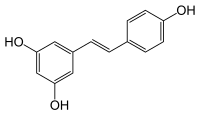
Photo from wikipedia
A number of stilbenoid and chalconoid derivatives were prepared by straightforward methods, and their ability to modulate tyrosinase activity and to scavenge free radicals were evaluated in vitro. The cell-free… Click to show full abstract
A number of stilbenoid and chalconoid derivatives were prepared by straightforward methods, and their ability to modulate tyrosinase activity and to scavenge free radicals were evaluated in vitro. The cell-free in vitro evaluation revealed two diarylpropanes, 24 and 25, as potent tyrosinase inhibitors, whereas diarylpropenoic acids seemed to enhance the enzymatic activity. An in silico evaluation of the binding affinity of the selected compounds with the crystal structure of tyrosinase was also conducted in order to obtain better insight into the mechanism. Representative synthetic compounds with inhibitory and activating properties were further evaluated in melanoma cell lines B16F1 and B16F10 for their ability to moderate tyrosinase activity and affect melanin production. Dihydrostilbene analogues I and II, exhibited a stronger anti-melanogenic effect than kojic acid through the inhibition of cellular tyrosinase activity and melanin formation, while diarylpropanoic acid 44 proved to be a potent melanogenic factor, inducing cellular tyrosinase activity and melanin formation. Moreover, the antioxidant evaluation disclosed two analogues (29 and 11) with significant free-radical-scavenging activity (12.4 and 20.3 μM), which were 10- and 6-fold more potent than ascorbic acid (122.1 μΜ), respectively.
Journal Title: Antioxidants
Year Published: 2022
Link to full text (if available)
Share on Social Media: Sign Up to like & get
recommendations!